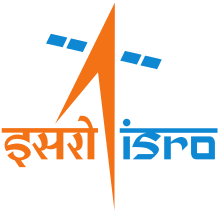GSLV Mark III
The Geosynchronous Satellite Launch Vehicle Mark III (GSLV Mk III),[1][15] also referred to as the Launch Vehicle Mark 3 (LVM3),[15] is a three-stage[1] medium-lift launch vehicle developed by the Indian Space Research Organisation (ISRO). Primarily designed to launch communication satellites into geostationary orbit,[16] it is also identified as launch vehicle for crewed missions under the Indian Human Spaceflight Programme and dedicated science missions like Chandrayaan-2.[17][18] The GSLV Mk III has a higher payload capacity than the similarly named GSLV Mk II.[19][20][21][22]
.jpg) GSLV Mk III D2 on Second Launch Pad, SDSC-SHAR | |
| Function | Medium-lift launch vehicle[1] |
|---|---|
| Manufacturer | Indian Space Research Organisation |
| Country of origin | India |
| Cost per launch | ₹367 crore (US$51 million) [2][3][4][5] |
| Size | |
| Height | 43.4 m (142 ft)[6][1] |
| Diameter | 4 m (13 ft)[6] |
| Mass | 640,000 kg (1,410,000 lb)[1] |
| Stages | 3[1] |
| Capacity | |
| Payload to LEO (600km) | 10,000 kg (22,000 lb)[7] |
| Payload to GTO | 4,000 kg (8,800 lb)[1] |
| Associated rockets | |
| Family | Geosynchronous Satellite Launch Vehicle |
| Comparable |
|
| Launch history | |
| Status | Active |
| Launch sites | Satish Dhawan Space Centre SLP, Andhra Pradesh, India |
| Total launches | 4 |
| Successes | 4 |
| Failures | 0 |
| First flight |
|
| Last flight | 22 July 2019 |
| Notable payloads | CARE, Chandrayaan-2 |
| First stage – S200 Boosters | |
| Length | 25 m (82 ft)[1] |
| Diameter | 3.2 m (10 ft)[1] |
| Empty mass | 31,000 kg (68,000 lb) each[8] |
| Gross mass | 236,000 kg (520,000 lb) each[8] |
| Propellant mass | 205,000 kg (452,000 lb) each[8] |
| Motor | Solid S200 |
| Thrust | 5,150 kN (525 tf)[9][10][11] |
| Specific impulse | 274.5 seconds (2.692 km/s) (vacuum)[8] |
| Burn time | 128 s[8] |
| Fuel | HTPB[8] |
| Second stage – L110 | |
| Length | 21.39 m (70.2 ft)[12] |
| Diameter | 4.0 m (13.1 ft)[8] |
| Empty mass | 9,000 kg (20,000 lb)[12] |
| Gross mass | 125,000 kg (276,000 lb)[12] |
| Propellant mass | 116,000 kg (256,000 lb)[12] |
| Engines | 2 Vikas engines |
| Thrust | 1,598 kN (163.0 tf)[8][13][14] |
| Specific impulse | 293 seconds (2.87 km/s)[8] |
| Burn time | 203 s[12] |
| Fuel | UDMH / N 2O 4 |
| Third stage – C25 | |
| Length | 13.545 m (44.44 ft)[8] |
| Diameter | 4.0 m (13.1 ft)[8] |
| Empty mass | 5,000 kg (11,000 lb)[12] |
| Gross mass | 33,000 kg (73,000 lb)[12] |
| Propellant mass | 28,000 kg (62,000 lb)[8] |
| Engines | 1 CE-20 |
| Thrust | 200 kN (20 tf)[8] |
| Specific impulse | 443 seconds (4.34 km/s) |
| Burn time | 643 s[8] |
| Fuel | LOX / LH2 |
After several delays and a sub-orbital test flight on 18 December 2014, ISRO successfully conducted the first orbital test launch of GSLV Mk III on 5 June 2017 from the Satish Dhawan Space Centre, Andhra Pradesh.[23]
In June 2018, the Union Cabinet approved ₹43.38 billion (US$610 million) to build 10 GSLV Mk III rockets over a five-year period.[24]
GSLV Mk III launched CARE, India's space capsule recovery experiment module, Chandrayaan-2, India's second lunar mission and will be used to carry Gaganyaan, the first crewed mission under Indian Human Spaceflight Programme.
History

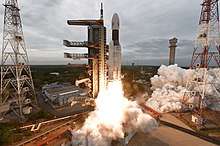
Development
ISRO initially planned two launcher families, the Polar Satellite Launch Vehicle for low Earth orbit and polar launches and the larger Geosynchronous Satellite Launch Vehicle for payloads to geostationary transfer orbit (GTO). The vehicle was reconceptualized as a more powerful launcher as the ISRO mandate changed. This increase in size allowed the launch of heavier communication and multipurpose satellites, future interplanetary exploration and will be human rated to launch crewed missions.[25] Development of the GSLV Mk III began in the early 2000s, with the first launch planned for 2009–2010.[26] The unsuccessful launch of GSLV D3, due to a failure in the cryogenic upper stage,[26] delayed the GSLV Mk III development program. The GSLV Mk III, while sharing a name with the GSLV, it features different systems and components.
S200 static fire tests
The first static fire test of the S-200 solid rocket booster, ST-01, was conducted on 24 January 2010. The booster fired for 130 seconds and had nominal performance. It generated a peak thrust of about 4,900 kN (1,100,000 lbf).[27][10] A second static fire test, ST-02, was conducted on 4 September 2011. The booster fired for 140 seconds and had nominal performance.[28] A third test, ST-03, was conducted on 14 June 2015 to validate the changes from the sub-orbital test flight data.[29][30]
L110 static fire tests
ISRO conducted the first static test of the L110 core stage at its Liquid Propulsion Systems Centre (LPSC) test facility at Mahendragiri, Tamil Nadu on 5 March 2010. The test was planned to last 200 seconds, but was terminated at 150 seconds after a leakage in a control system was detected.[31] A second static fire test for the full duration was conducted on 8 September 2010.[32]
C25 stage tests

The first static fire test of the C25 cryogenic stage was conducted on 25 January 2017 at the ISRO Propulsion Complex (IPRC) facility at Mahendragiri, Tamil Nadu. The stage was tested for a duration of 50 seconds and had nominal performance.[33]
A second static fire test for the full in-flight duration of 640 seconds was completed on 17 February 2017.[34] This test demonstrated the repeatability of the engine performance along with its sub-systems, including the thrust chamber, gas generator, turbopumps and control components for the full duration. All of the engine parameters had nominal performance.[34]
Redesigns
After the suborbital test flight of GSLV Mk III, modifications were made to the vehicle to improve performance. The propellant grain geometry of head end segment was changed to a 13-lobed star configuration from a 10-lobed slotted configuration and propellant load was reduced to 205 tonnes (452,000 lb) to improve performance during transsonic flights.[35] The payload fairing was modified to an ogive shape, and the S200 booster nosecones were slanted to improve aerodynamic performance. The inter-tank structure of the C25 cryogenic stage was redesigned for density.[35]
Vehicle design
The first stage consists of two S200 solid motors, also known as Large Solid Boosters (LSB) attached to the core stage. Each booster is 3.2 metres (10 ft) wide, 25 metres (82 ft) long, and carries 207 tonnes (456,000 lb) of propellant. The S200 booster uses an HTPB based propellant. It is the largest solid-fuel booster after the Space Shuttle SRBs and Ariane 5 SRBs. The flex nozzles can be vectored using electro-hydraulic actuators and are used for vehicle control during the initial ascent phase.[36][37] These boosters burn for 130 seconds and produce an average thrust of 3,578.2 kilonewtons (804,400 lbf) and a peak thrust of 5,150 kilonewtons (1,160,000 lbf) each.[36][9]
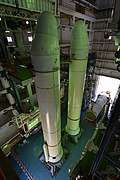

The second stage, designated L110, is a liquid-fueled stage that is 21 metres (69 ft) tall and 4 metres (13 ft) wide, and contains 110 metric tons (240,000 lb) of unsymmetrical dimethylhydrazine (UDMH) and nitrogen tetroxide (N
2O
4). It is powered by two Vikas 2 engines, each generating 766 kilonewtons (172,000 lbf) thrust, giving a total thrust of 1,532 kilonewtons (344,000 lbf).[13][14] The L110 is the first Indian clustered liquid-fueled engine. The Vikas engines uses regenerative cooling, providing improved weight and specific impulse compared to earlier Indian rockets.[36][38] Each Vikas engine can be individually gimbaled to control vehicle pitch, yaw and roll control. The L110 core stage ignites 114 seconds after liftoff and burns for 203 seconds.[36][14]
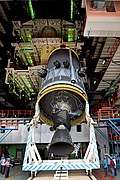
The cryogenic upper stage, designated C25, is 4 metres (13 ft) in diameter and 13.5 metres (44 ft) long, and contains 28 metric tons (62,000 lb) of propellant LOX and LH2.[38] It is powered by the CE-20 engine, producing 200 kN (45,000 lbf) of thrust. CE-20 is the first cryogenic engine developed by India which uses a gas generator, as compared to the staged combustion engines used in GSLV.[39]
The payload fairing has a diameter of 5 metres (16 ft) and a payload volume of 110 cubic metres (3,900 cu ft).[8]
Upgrades
The L110 core stage in GSLV Mk III is planned to be replaced by a kerolox stage powered by SCE-200[40] to increase its payload capacity to 6 metric tons (13,000 lb) to GTO.[41] SCE-200 uses kerosene instead of UDMH as fuel and can exert a thrust of around 200 tonnes. Four of such engines can be clustered in a rocket without strap on boosters to deliver up to 10 tonnes (22,000 lb) to GTO.[42]
Propellant load on hydrolox upper stage is planned to be increased to 30 t (66,000 lb) from 25 t (55,000 lb). The first flight of the upgraded GSLV Mk III is expected in December 2020, but the SCE-200 powered version will not be used for the crewed mission of the Gaganyaan spacecraft.[43][44]
In September 2019, a report quoted S. Somanath, director of VSSC who said that semi-cryogenic engine was ready for testing to begin. SCE-200 is reported to be based on Ukrainian RD-810.[45]
As per a frame agreement for cooperation in the peaceful uses of outer space between India and Ukraine signed in 2005, Ukraine was expected to test components of the Indian version of the engine. and will fly only after successful completion of the Gaganyaan program. So, an upgraded version of the GSLV Mk III will not arrive before 2022.[46]
Notable missions
.jpg) GSLV Mk III D2 lifting off
GSLV Mk III D2 lifting off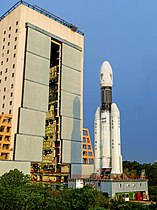 D1 on its Mobile Launch Pedestal on its way to the launchpad
D1 on its Mobile Launch Pedestal on its way to the launchpad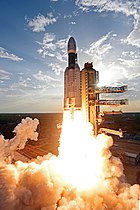 GSLV Mk III D1 lifting off
GSLV Mk III D1 lifting off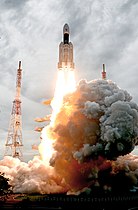 GSLV Mk III M1 lifting off
GSLV Mk III M1 lifting off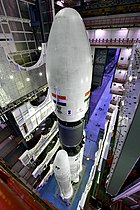 M1 at the Vehicle Assembly Building
M1 at the Vehicle Assembly Building
X (Suborbital flight test)
The maiden flight of the GSLV Mk III occurred on 18 December 2014. The flight lifted off from the Second Launch Pad, at 04:00 UTC.[47] The test had functional boosters, a core stage and a non-functional dummy upper stage. It carried the Crew Module Atmospheric Re-entry Experiment (CARE) that was tested on re-entry.[48]
Just over five minutes into the flight, the rocket ejected CARE module at an altitude of 126 kilometres (78 mi), which then descended, controlled by its onboard motors. During the test CARE's heat shield experienced a maximum temperature of around 1,000 °C (1,830 °F). ISRO downloaded launch telemetry during the ballistic coasting phase before the radio black-out to avoid data loss in the event of a splash-down failure. At an altitude of around 15 kilometres (9.3 mi), the module's apex cover separated and the parachutes were deployed. CARE splashed down in the Bay of Bengal near the Andaman and Nicobar Islands and was recovered successfully.[49][50][51][52]
D1 (GSAT-19)
The first orbital flight of the GSLV Mk III occurred on 5 June 2017,[53] lifting off from the Second Launch Pad at 11:58 UTC. The vehicle carried the GSAT-19 communication satellite, making it the heaviest Indian rocket and payload ever launched. The satellite was successfully placed into a geostationary transfer orbit (GTO) at 170 kilometres (110 mi). The flight also tested upgrades to the design from data acquired during the suborbital test flight (See section on redesigns).[54]
M1 (Chandrayaan-2)
The first operational flight occurred on 22 July 2019,[55][18] lifting off from the Second Launch pad at 9:13 UTC. The rocket carried Chandrayaan-2, India's second mission to the Moon, consisting of an orbiter, lander and a rover.[56] The Chandrayaan-2 stack is the heaviest spacecraft launched by ISRO.[57]
Launch history
| Flight № | Date / time (UTC) | Rocket, configuration |
Launch site | Payload | Payload mass | Orbit | User | Launch outcome |
|---|---|---|---|---|---|---|---|---|
| X | 18 December 2014 04:00[58] |
LVM3-X | Second Launch Pad | 3,775 kg (8,322 lb)[59] | Sub-orbital | ISRO | Success | |
| Sub-orbital development test flight with non-functional cryogenic stage[60] | ||||||||
| D1 | 5 June 2017 11:58[61][62][63] |
Mk III | Second Launch Pad | 3,136 kg (6,914 lb) | GTO | INSAT | Success | |
| First orbital test launch with a functional cryogenic stage[64] | ||||||||
| D2 | 14 November 2018 11:38 |
Mk III | Second Launch Pad | 3,423 kg (7,546 lb) | GTO | INSAT | Success | |
| Second orbital test flight. L110 core used upgraded Vikas engines with higher thrust.[65][66][67] | ||||||||
| M1 | 22 July 2019 09:13 | Mk III | Second Launch Pad | 3,850 kg (8,490 lb) | EPO | ISRO | Success | |
| First operational flight of GSLV MK-III. | ||||||||
Planned launches
| Date / time (UTC) | Rocket, Configuration |
Launch site | Payload | Orbit |
|---|---|---|---|---|
| Mid-2020 | Mk III | Second Launch Pad | GTO | |
| [68][69] | ||||
| December 2020[70] | Mk III | Second Launch Pad | LEO | |
| First uncrewed orbital demonstration flight of India's crew module.[46] | ||||
| July 2021[70] | Mk III | Second Launch Pad | LEO | |
| Second orbital demonstration flight of crew module. | ||||
| TBA | Mk III | Second Launch Pad | GTO | |
| [71] | ||||
| December 2021[72][73][70] | Mk III | Second Launch Pad [74][75] | LEO | |
| India's first crewed mission. Launch mass is 7,800 kg (17,200 lb) with service module,[76] capsule's mass is 3,735 kg.[76][46] | ||||
| 2023[77] | Mk III | Second Launch Pad | TBD | |
| Launch mass is 2,500 kg; Venus orbiter and atmospheric balloon. | ||||
| TBA | Mk III | Second Launch Pad | TBD | |
| [79][80][46] | ||||
See also
- Comparison of orbital launchers families
- Comparison of orbital launch systems
- Gaganyaan, India's crewed orbiter
- Geosynchronous Satellite Launch Vehicle
- List of Indian satellites
- Medium-lift launch vehicle, capable of lifting between 2,000 and 20,000 kg (4,400 and 44,100 lb) of payload into Low Earth orbit
- Polar Satellite Launch Vehicle
References
- "GSLV Mk III". Indian Space Research Organisation. Retrieved 20 September 2018.
- "Launch of Chandrayaan-II". Retrieved 29 January 2020.
- "Chandrayaan-2 launch on July 15: ISRO". 25 July 2019. Retrieved 25 July 2019.
- "Historic Day, Says ISRO As India's 'Baahubali' Rocket Lifts Off: 10 Facts". NDTV. Retrieved 30 May 2018.
- Narasimhan, T. E. (5 June 2017). "'Fat Boy' GSLV-MK III launches today: The rocket has cost India Rs 400 cr". Business Standard. Retrieved 30 May 2018.
- "The first developmental flight of GSLV-Mk-III". Indian Space Research Organisation. Retrieved 30 May 2018.
- "GSLV MkIII-M1 Successfully Launches Chandrayaan-2 spacecraft - ISRO". www.isro.gov.in. ISRO. Retrieved 23 July 2019.
- "LVM3". Archived from the original on 25 December 2014. Retrieved 21 December 2014.
- "ISRO Press Release: S200 First Static Test (S-200-ST-01)" (PDF). Archived from the original (PDF) on 11 March 2013. Retrieved 17 June 2017.
- "Isro successfully tests world's 3rd largest solid booster". dna. Retrieved 4 October 2014.
- "India to test world's third largest solid rocket booster". Science and Technology Section. The Hindu News Paper. 7 December 2009. Retrieved 7 December 2009.
- "GSLV Mark III-D1 / GSAT-19 Brochure". IRSO. Archived from the original on 18 November 2018. Retrieved 3 June 2017.
- "GSLV Mk3". Space Launch Report. Retrieved 23 October 2014.
- "L110 test to follow S200". IndianSpaceWeb. Retrieved 15 October 2014.
- "As it happened: ISRO successfully launches GSLV Mark-III". The Hindu. 17 December 2014. ISSN 0971-751X. Retrieved 30 May 2018.
- "'India masters rocket science': Here's why the new ISRO launch is special".
- "Two international astronauts survive space scare. How well is India prepared?".
- "GSLV-Mk III, India's 'Baahubali' rocket for Gaganyaan, Chandrayaan II".
- "Indian Space Research Organisation preparing for three more PSLV launches". The Hindu. 29 April 2011. ISSN 0971-751X. Retrieved 30 May 2018.
- Ramachandran, R. (22 January 2014). "GSLV MkIII, the next milestone". Frontline. Retrieved 30 May 2018.
- Sengupta, Rudraneil (5 June 2017). "Cryogenic rocket engine has been developed from scratch: Isro chief". LiveMint. Retrieved 30 May 2018.
- "India launches 'monster' rocket". BBC News. 5 June 2017. Retrieved 30 May 2018.
- "India's 'Bahubali' GSLV Mk III lifts less luggage than lighter rockets". The Economic Times. 16 June 2017. Archived from the original on 18 June 2017.
- "Government approves Rs 10,000-crore continuation programmes for PSLV, GSLV". The Economic Times. 7 June 2018. Retrieved 8 June 2018.
- ISRO Not To Fly Living Being Before Actual Manned Space Mission: Official. NDTV Indo-Asian News Service. 14 September 2018.
- "India's GSLV Mk-3 First Flight Pushed Back to April 2014". Sawfnews. 4 April 2013. Archived from the original on 10 April 2013. Retrieved 19 December 2014.
- "Successful static testing of Solid Propellant Booster Rocket Stage S200 for GSLV Mk III Launch Vehicle". www.isro.gov.in. Retrieved 12 February 2018.
- "Second Static Testing of Solid Propellant Booster Rocket Stage S200 for GSLV-Mk III Successfully Conducted". VSSC.gov.in. Archived from the original on 12 February 2018. Retrieved 12 February 2018.
- "విజయవంతంగా భూస్థిర పరీక్ష". Sakshi. 15 June 2015. Retrieved 12 February 2018.
- Reporter, Staff (15 June 2015). "Static test of S200 motor successful". The Hindu. ISSN 0971-751X. Retrieved 12 February 2018.
- "ISRO successfully conducts static testing of new age rocket". The Hindu. Retrieved 4 October 2014.
- "ISRO Press Release:Successful Static Testing of L 110 Liquid Core Stage of GSLV - Mk III". Archived from the original on 2 February 2014. Retrieved 17 June 2017.
- "ISRO Successfully Tests C25 Cryogenic Upper Stage of GSLV MkIII". Indian Space Research Organisation. Retrieved 30 May 2018.
- "ISRO Successfully Tests its Cryogenic Stage (C25) for GSLV MkIII for the Flight Duration". Indian Space Research Organisation. Archived from the original on 9 June 2017. Retrieved 17 June 2017.
- Department of Space, Government of India. "Outcome Budget 2016-17" (PDF). isro.gov.in. Department of Space, Government of India. Archived from the original (PDF) on 26 November 2016. Retrieved 1 June 2017.
- "GSLV Mk. III Launch Vehicle Overview". Spaceflight 101. Wayback Machine. Archived from the original on 11 February 2018. Retrieved 11 February 2018.
- N. Gopal Raj. "GSLV Mark III faces its first experimental flight". The Hindu.
- LVM3 Archived 25 December 2014 at the Wayback Machine ISRO 23 December 2014
- "Why ISRO's New Engine and Mk III Rocket Are Reasons to Forget 1990 Cryogenic Scandal". TheWire. Wayback Machine. Archived from the original on 11 February 2018. Retrieved 11 February 2018.
- Rajwi, Tiki (2 March 2015). "Semi-cryogenic Engine: ISRO Charting a Revised Plan". New Indian Express. Retrieved 20 May 2018.
- "ISRO developing heavy lift launch vehicles". The Hindu. 30 May 2015. Retrieved 20 May 2018.
- "Ukraine to test components of a powerful Indian rocket engine". russianspaceweb.com. Retrieved 20 September 2019.
- "The ISRO Tender Notice With Fascinating New Details of Gaganyaan". Retrieved 29 January 2019.
- Singh, Surendra (28 January 2019). "GSLV Mk III: Isro eyes kerosene to boost GSLV Mk III's lifting power to 6 trillion". The Times of India. Retrieved 31 July 2019.
- "ISRO moves on, gears up to test semi-cryogenic engine in Ukraine". The Hindu. 19 September 2019. Retrieved 20 September 2019.
- "Episode 90 – An update on ISRO's activities with S Somanath and R Umamaheshwaran". AstrotalkUK. 24 October 2019. Retrieved 30 October 2019.
- "India launches largest rocket and unmanned capsule". BBC. 8 December 2014. Retrieved 20 May 2018.
- "ISRO inches closer to manned mission". Timesofindia.indiatimes.com. 10 January 2014. Retrieved 10 January 2014.
We will be checking the crew capsule for all parameters.
- "ISRO's unmanned crew module reaches Chennai". The Hindu. Wayback Machine. Archived from the original on 11 February 2018. Retrieved 11 February 2018.
- As it happened: Isro's launch of India's heaviest rocket Times of India 18 December 2014
- Sangeetha Kandavel. "GSLV Mark III takes to the skies in test flight". The Hindu.
- "Isro to test GSLV Mk-III, crew module on December 18". The Times of India. Retrieved 11 December 2014.
- "GSLV Mk III breaks Isro's jinx of failure in debut rocket launches".
- Clark, Stephen (5 June 2017). "India's launcher fleet gets an upgrade with successful test flight". Spaceflight Now. Retrieved 25 April 2018.
- "Chandrayaan 2 lifts off successfully". Times of India. 22 July 2019. Retrieved 22 July 2019.
- "India Launches Chandrayaan-2 Moon Mission". The New York Times. 22 July 2019. Retrieved 22 July 2019.
- Rajwi, Tiki (4 May 2019). "Chandrayaan-2 most complex mission: ISRO chief Sivan". The Hindu. ISSN 0971-751X. Retrieved 8 October 2019.
- "GSLV Mk-III: ISRO successfully test flies its heaviest rocket". The Economic Times. New Delhi. 18 December 2014. Retrieved 18 December 2014.
- "First Experimental Flight of India's Next Generation Launch Vehicle GSLV Mk-III Successful". 18 December 2014. Archived from the original on 22 December 2014. Retrieved 22 December 2014.
- "GSLV MkIII to launch Isro's next mission". Hindustan times. 1 July 2014. Retrieved 1 July 2014.
- "India's GSAT-19 Reaches Geostationary Orbit after Off-Target Injection". Spaceflight101. 10 June 2017. Retrieved 12 February 2018.
- "GLSV Mark III rocket conducts 'all-up' launch with GSAT-19 satellite". NASA Spaceflight. Wayback Machine. Archived from the original on 11 February 2018. Retrieved 11 February 2018.
- "Isro successfully launches its monster rocket GSLV Mk III". The Economic Times. Retrieved 11 February 2018.
- "GSLV Mk III-D1/GSAT-19 Mission - ISRO". www.isro.gov.in. Retrieved 17 June 2017.
- "Successful Qualification of High Thrust Vikas Engine - ISRO". www.isro.gov.in. Retrieved 18 November 2018.
- "GSLV F08-GSAT6A Brochure - ISRO". www.isro.gov.in. Retrieved 18 November 2018.
- "With eye on lunar mission, ISRO to test high-thrust Vikas engine". The New Indian Express. Retrieved 18 November 2018.
- "Annual Report 2018" (PDF). ISRO. Retrieved 28 May 2019.
- www.ETTelecom.com. "GSAT-20 planned for mid-2020: Isro's K Sivan - ET Telecom". ETTelecom.com. Retrieved 28 November 2019.
- "India's first manned space flight by December 2021, says ISRO chief K Sivan". LiveMint. 22 September 2019. Retrieved 25 September 2019.
- "Annual Report 2017-18, Department of Space". ISRO.gov.in. Department of Space, Government of India. Retrieved 13 February 2018.
- Gaganyaan mission to take Indian astronaut to space by 2022: PM Modi. The Hindu. 15 August 2018.
- "It's not just an ISRO project, it's a national one: K Sivan".
- "India's human space programme gets a fillip". The New Indian Express. Retrieved 23 July 2019.
- Inside India's 2022 Space Mission: NDTV Special, retrieved 23 July 2019
- Indian Manned Spacecraft. Astronautix. 2014.
- "India seeks collaborators for a mission to Venus, the neglected planet". Science | AAAS. 21 November 2018. Retrieved 21 November 2018.
- "India plans second Mars mission in 2018". CNN-News18. 29 October 2014. Retrieved 30 August 2019.
- Jatiya, Satyanarayan (18 July 2019). "Rajya Sabha Unstarred Question No. 2955" (PDF). Retrieved 30 August 2019. Alt URL
- Madhumathi, D.S. (10 August 2016). "ISRO sets the ball rolling for Mars Mission-2". The Hindu. Retrieved 27 April 2017.
External links
| Wikimedia Commons has media related to Geosynchronous Satellite Launch Vehicle Mark III. |
